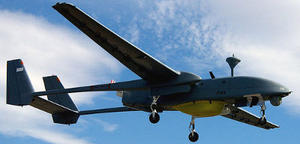UAV updateExperts call for rules of the road for drone use in the Americas
More and more Latin and Central American countries are using UAVs for domestic policing missions; these drones are employed as a high-tech answer by government to problems such as drug trafficking, gang violence, deforestation, and other illegal activities; experts say that Latin American countries should collaborate in developing a code of conduct that will prevent the arming of drones and assuage civilian concerns

Mexico purchased several Israeli-built Heron UAVs // Source: defence.pk
More and more Latin and Central American countries are using UAVs for domestic policing missions. The These drones are employed as a high-tech answer by government to problems such as drug trafficking, gang violence, deforestation, and other illegal activities.
The Christian Science Monitor reports that from Canada to Brazil, at least eleven nations are flying UAVs – often Israeli made — over the Western Hemisphere:
- The United States has been using drones to patrol the U.S.-Mexico border, and the New York Times and Reuters recently revealed that U.S. drones, with the consent of the Mexican government, have been flying missions deep into Mexico in order to track the drug cartels
- Mexico in 2008 deployed its own drones to crime-plagued Ciudad Juárez and today operates up to thirty UAVs nationwide
- UAV surveillance programs also exist in Argentina, Brazil, Ecuador, Chile, Colombia, Peru, Uruguay, and Venezuela
- Israel Aerospace Industries (IAI) has sold its Heron to Mexico and Ecuador, where it has a branch in addition to offices in Brazil, Colombia, and Chile
- Another Israeli firm, Elbit Systems Ltd., has sold its Hermes to Mexico and Brazil
- In April, Elbit signed a “strategic agreement” with Brazilian aircraft manufacturer Embraer, which lauded drones’ “dual-use for monitoring of ports, agricultural, forest, and coastal areas, traffic, etc.”
- Brazil has been dispatching the Heron to its porous western frontier — the 10,500-mile border touches ten nations
- Brazilian police are considering flying drones over violent cities and the Amazon to fight deforestation and illegal exploitation of natural resources. Police spokesman said that fourteen Heron drones will be purchased by 2014 for $395 million
The growing presence of drones has led to calls for regulating their use. Experts say that Latin American countries should collaborate in developing a code of conduct that will prevent the arming of drones and assuage civilian concerns. Johanna Mendelson Forman, a Latin America specialist at the Center for Strategic and International Studies (CSIS), in Washington, D.C., told the Monitor: “I think it’s the maturation of Latin American defense systems,” she says, while cautioning that the potential to arm drones could turn the project into a “double-edged sword.”
